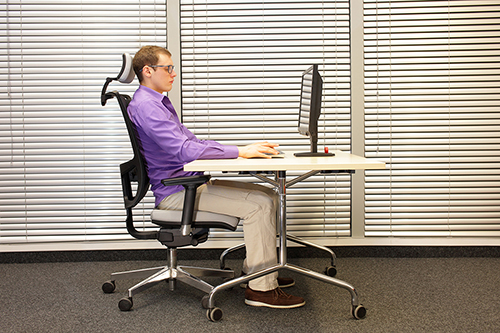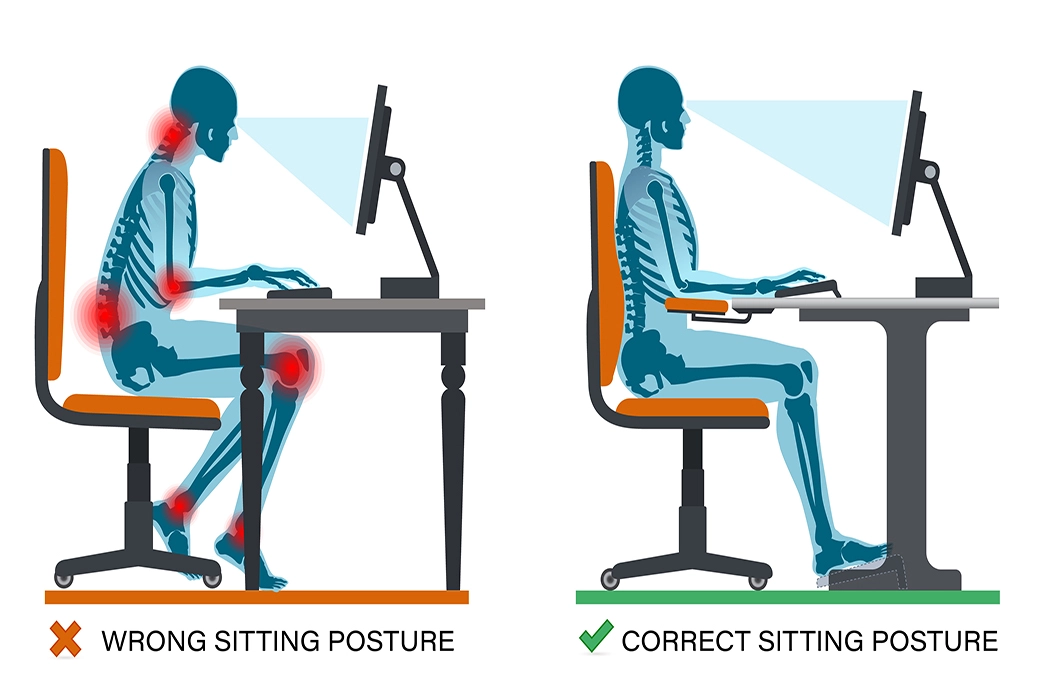If you suffer from SI joint pain, you may find that sitting can often aggravate the pain to unbearable levels. But you can fight this.
The way you sit can impact your SI joint pain. These three simple tips can help relieve your pain:
- Sit Properly (minding your posture)
- Take Frequent Breaks
- Alternate Between Sitting and Standing
If you follow these hints, you may be surprised at how much they do for you.
The Science of SI Joint Pain
SI Joint Pain is fairly common and of significant import. According to a study on Ingenta Connect, “as many as 30% of patients presenting with low back pain” can trace the origin of the pain back to SIJD (Sacroiliac Joint Dysfunction). (1)
Another study, this one from the Spine Journal on ScienceDirect found significant differences in functionality in patients’ legs depending upon whether they suffered from SIJD (Sacroiliac Joint Dysfunction) or not. (2) Differences included a greater VGRF (vertical ground reaction force) and greater peak hip moment in the uninjured leg of patients, and a smaller range of motion as well as a delay in the onset of a key muscle on the injured side of patients.
Of course, not all the news is bad:
A study on ScienceDirect from the Journal of Manipulative and Physiological Therapeutics found a short regimen of chiropractic manipulations – whether mechanically or manually implemented – proved to help reduce pain and disability in “patients diagnosed with sacroiliac joint syndrome.” (3)
Let’s dig in a little deeper and take a closer at the impact sitting can have on your SI joint pain issues.
Every human being has two sacroiliac (SI) joints: one on either side of the body. Each joint serves to connect the sacrum with the corresponding iliac bones on the pelvis. These joints serve to stabilize that portion of the body by absorbing shocks and helping transfer loads from the spine to the legs.
The SI joints themselves are held together with thick ligaments and normally do not move very much. Sacroiliac joint pain can result from a variety of causes, from injuries to arthritis and more.
Once one has acquired SI pain, many normal day-to-day activities can become difficult and painful. One of the most common such activities is simply sitting. Of particular concern, is how you sit, how long you sit, and how such activities impact your SI joint pain.
Many people find that sitting often results in increased joint pain. To fight against this, there are a few rules of thumb to follow.
1) Sit Properly
This is the most important rule to keep in mind. As with many other musculoskeletal issues, SI joint pain can be significantly impacted by posture. This includes your posture when sitting. To sit properly, follow this short list of guidelines:
- Keep your chest up and your shoulders relaxed
- Keep your hips level and your legs uncrossed and slightly spread
- Keep your weight distributed evenly on both sides of the body
- Rest your back against the chair
- And, if necessary, you can use a lumbar support pillow
Ideally, you should invest in and use an ergonomic chair to sit in. If you do so, you’ll find that you will naturally assume a good sitting posture in the ergonomic chair. Still, it’s good to review your posture, and, if necessary, consult a chiropractor, if you find yourself suffering from pain.
2) Take Frequent Breaks
It’s generally a bad idea to remain sitting for hours on end and never getting up or moving. That just has a tendency to magnify smaller SI joint issues into bigger SI joint issues. But if you get up every thirty or forty minutes, this will give you a chance to stretch, relax, and alleviate some of the stress.
3) Alternate Standing and Sitting
If you have a standing desk, definitely make use of it. Although some people do find that standing for a long period of time has as many drawbacks as sitting for that long, a standing desk allows you to alternate between the two. This can be very helpful at reducing SI joint pain and other issues.
Those three tips are probably the most important to keep in mind over the short term. For the long term, for the health of your SI joint and the rest of your body, you should look into developing an exercise program. A good place to start would be talking to a chiropractor. As experts in the musculoskeletal system, a chiropractor can recommend a variety of exercises you can do as well as a number of exercises to avoid.
How To Sit In A Car With SI Joint Pain?
Sitting in a car with SI joint pain is only slightly different than sitting simply in a chair. One of the largest differences may just be getting in and out of the vehicle. You always approach from the side rather than just plop down from the front. But if you can do so without excess pain, once you are in the car seat, you should take the time to adjust the seat bearing these following items in mind:
- Keep your spine straight
- Keep your knees slightly bent
- Keep your hips level with your knees
- Place the headrest around the middle of the head
If you have further concerns or questions, you can contact a chiropractor.

What Is The Best Sitting Position For Your SI Joint?
To a certain extent, the answer to this question varies from individual to individual (and chair to chair). But, generally, if you follow the tips above, you should be able find a suitable sitting position to serve you. If necessary, you can consult a chiropractor to “tweak” your ideal position.
Just remember that posture is critical. As a rule, you don’t want to place unnecessary pressure on your back or hips, or even neck. You can do this, if you keep the other parts of your body properly aligned – hips, torso, head, shoulders, etc…
You should also find that the proper position will provide you with enough comfort that you need not shift around much, and enough support that your lower back remains relatively stress free.
Does Sitting Worsen Sacroiliitis?
The answer to this question is: it depends.
If you have sacroiliitis, and you have a tendency to sit wrong – slouched over, legs crossed, etc… – it is possible that you may worsen the condition. Poor posture can be a nightmare sometimes.
However, if you sit properly, as noted above (or as your own chiropractor recommended), you should be okay. Sitting with good posture and taking frequent breaks should, in many cases, keep your sacroiliitis from getting worse. If you find otherwise, you should definitely contact your chiropractor and/or other medical professional to discuss the matter.
Chiropractors are privy to a number of ways of getting back pain relief – including sacroiliiatis.
How To Relieve SI Joint Pain When Sitting?
If you are following the tips above, those should go a long way in reducing SI pain aggravated by sitting. Of course, some cases of SI pain are more severe than others. To help fight those cases where proper sitting is not doing the full job, you have a few other tools to work with. The first to look at is how you sleep.
The proper sleeping position can bring SI joint pain relief in some cases. Not necessarily all, but many. Other items at your disposal include:
- OTC Pain Meds
- Hot and Cold Compresses
- Proper Diet
- And Exercise: Note on this last item, not all exercises are equal. For example, you should avoid sit-ups, crunches, and jumping rope (among others). At the same time, you should do seated backbends and spinal twists (among others).
For a complete discussion on exercise and other SI Joint Pain issues, contact your chiropractor.
Conclusion
Ultimately, if you have SI Joint Pain you should be aware of what you can do to help alleviate it. You may find that just being mindful of how to sit can bring great relief. However, obviously, serious pain needs to be dealt with under the direction of a medical professional. To that end, Better Health Alaska has in its employ a group of dedicated physical therapists, massage therapists, chiropractors, and nurse practitioners, all highly-qualified and eager to help you.









